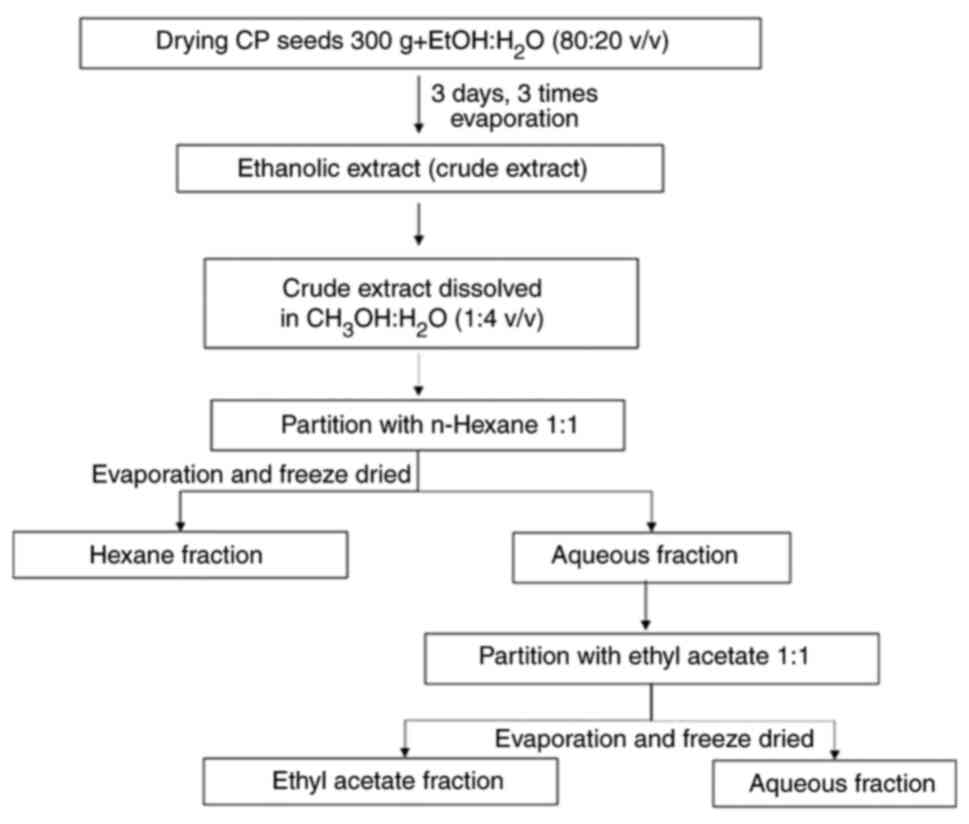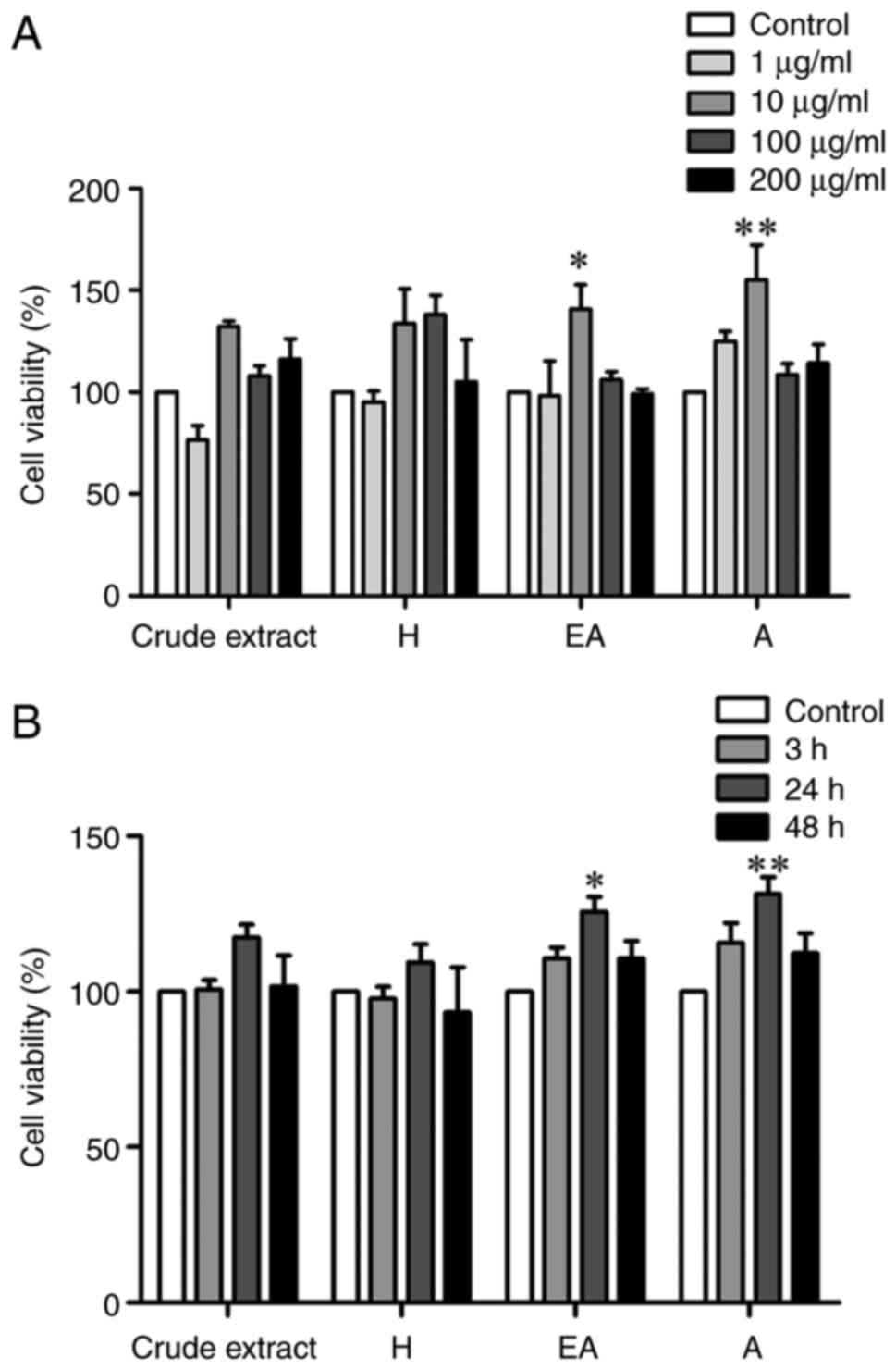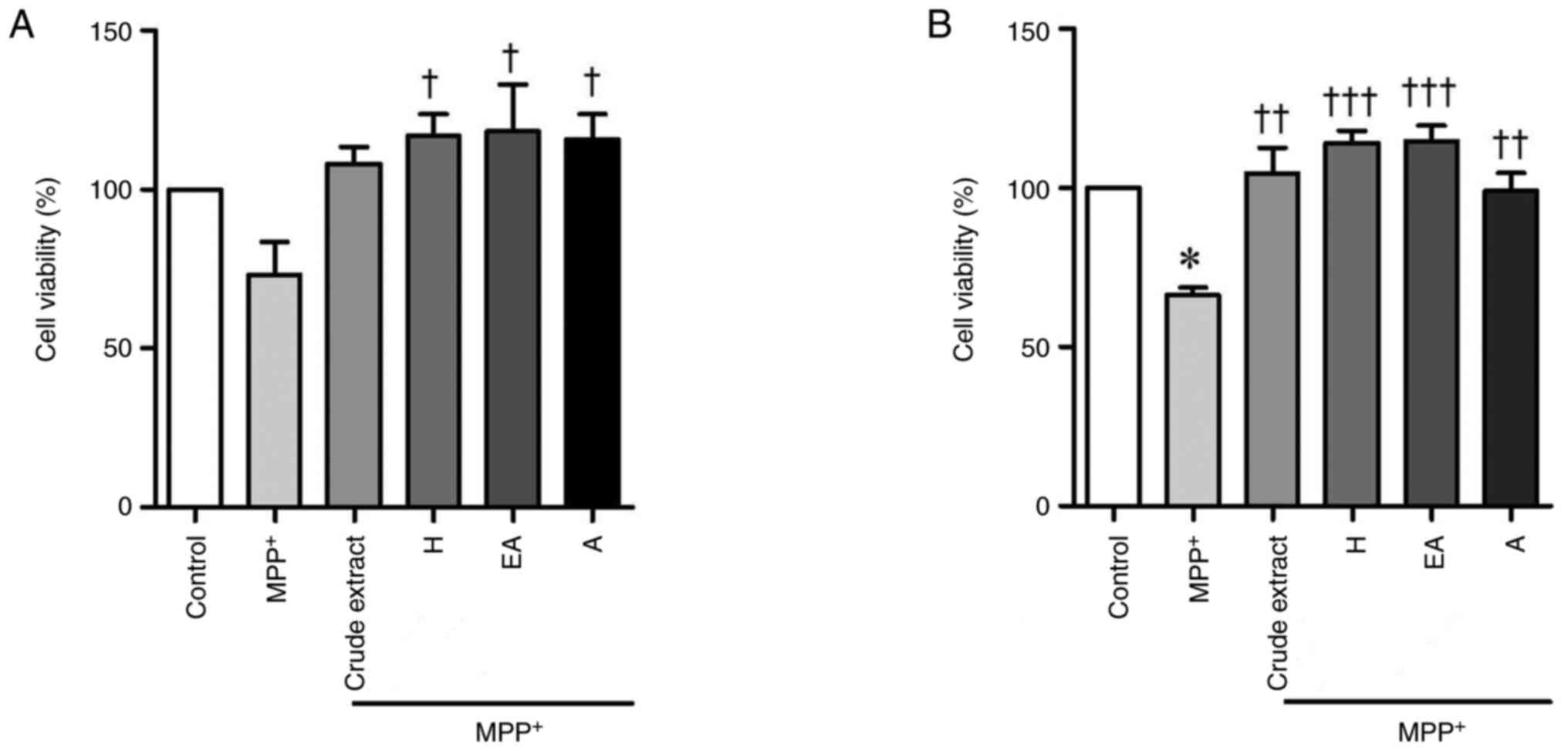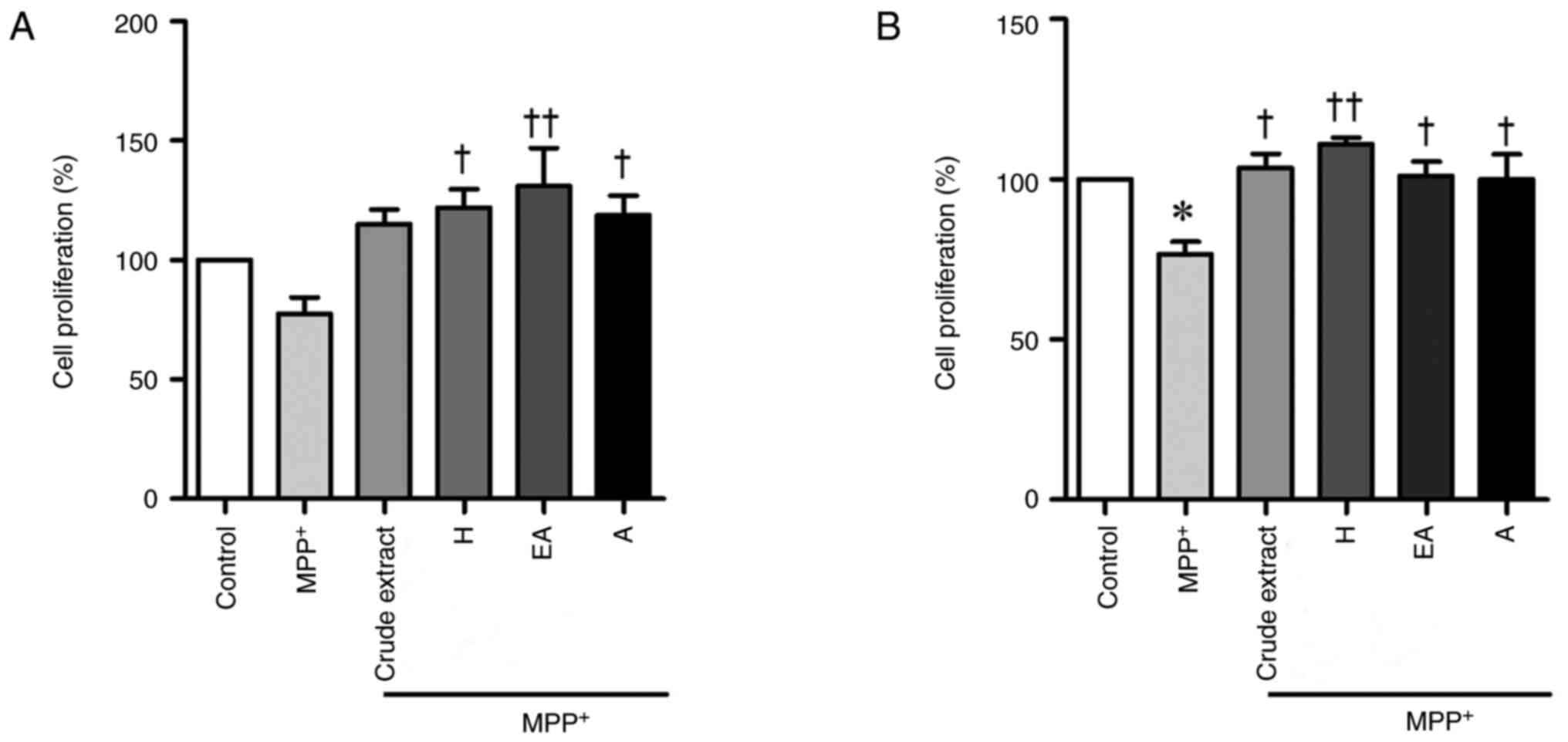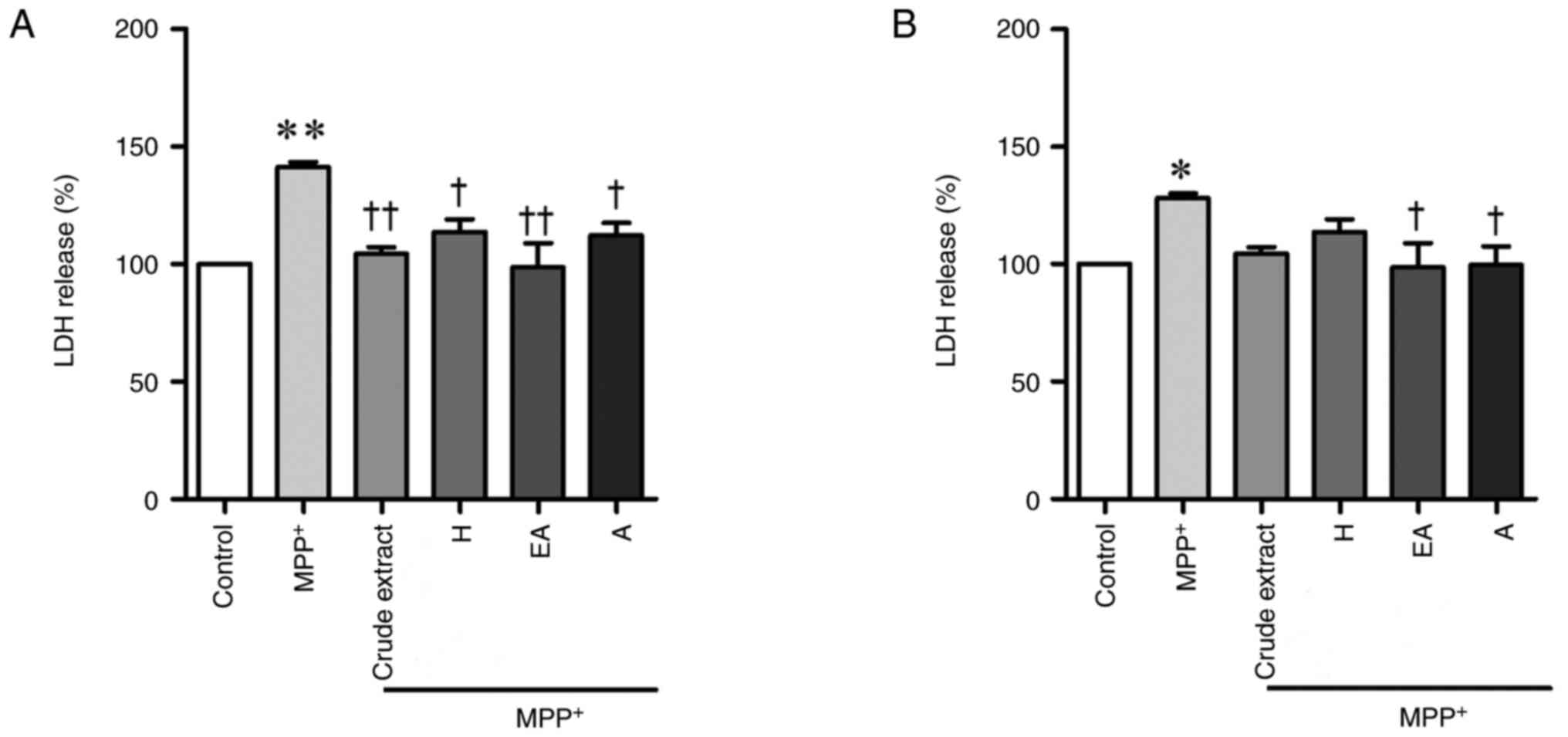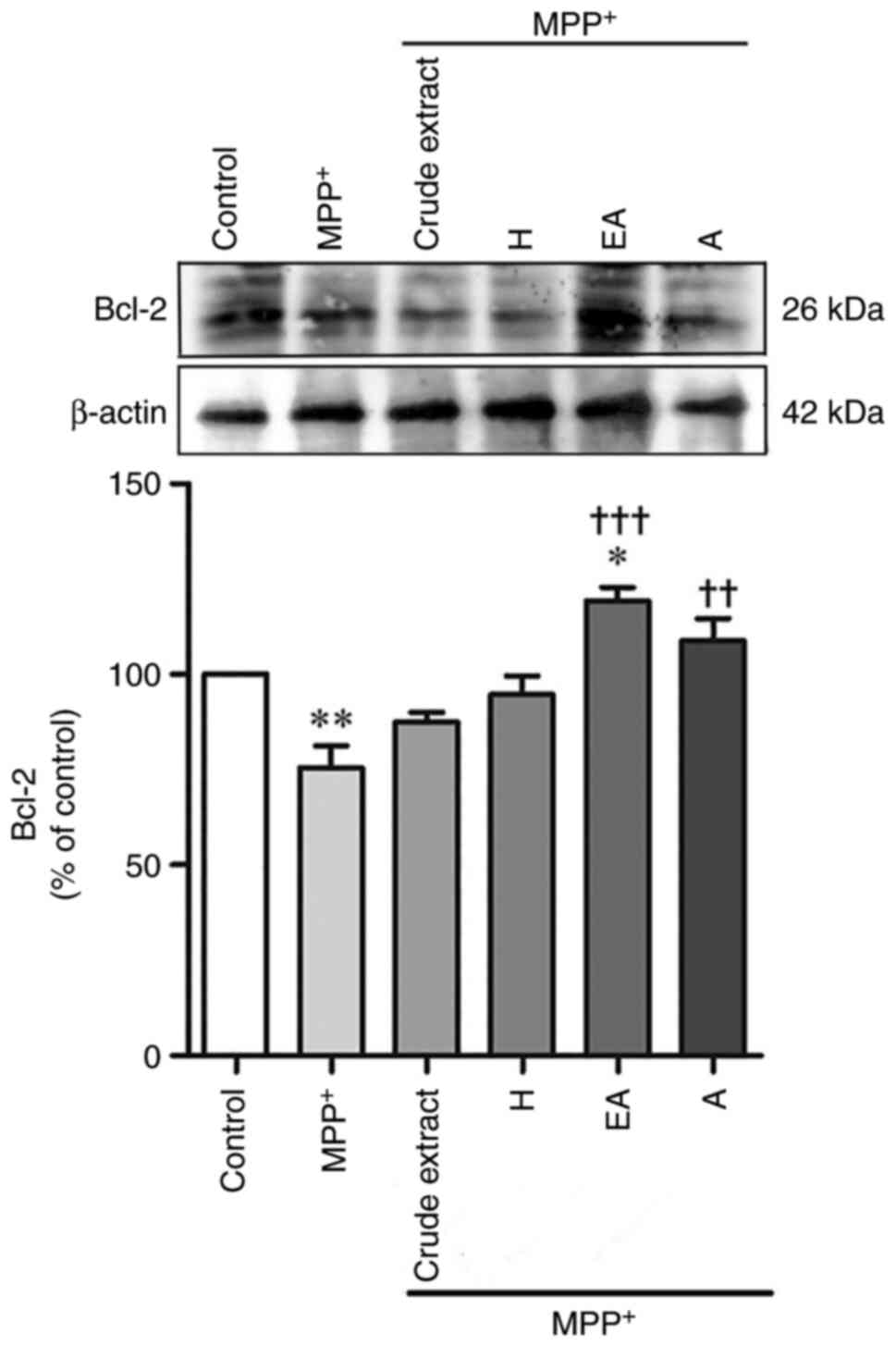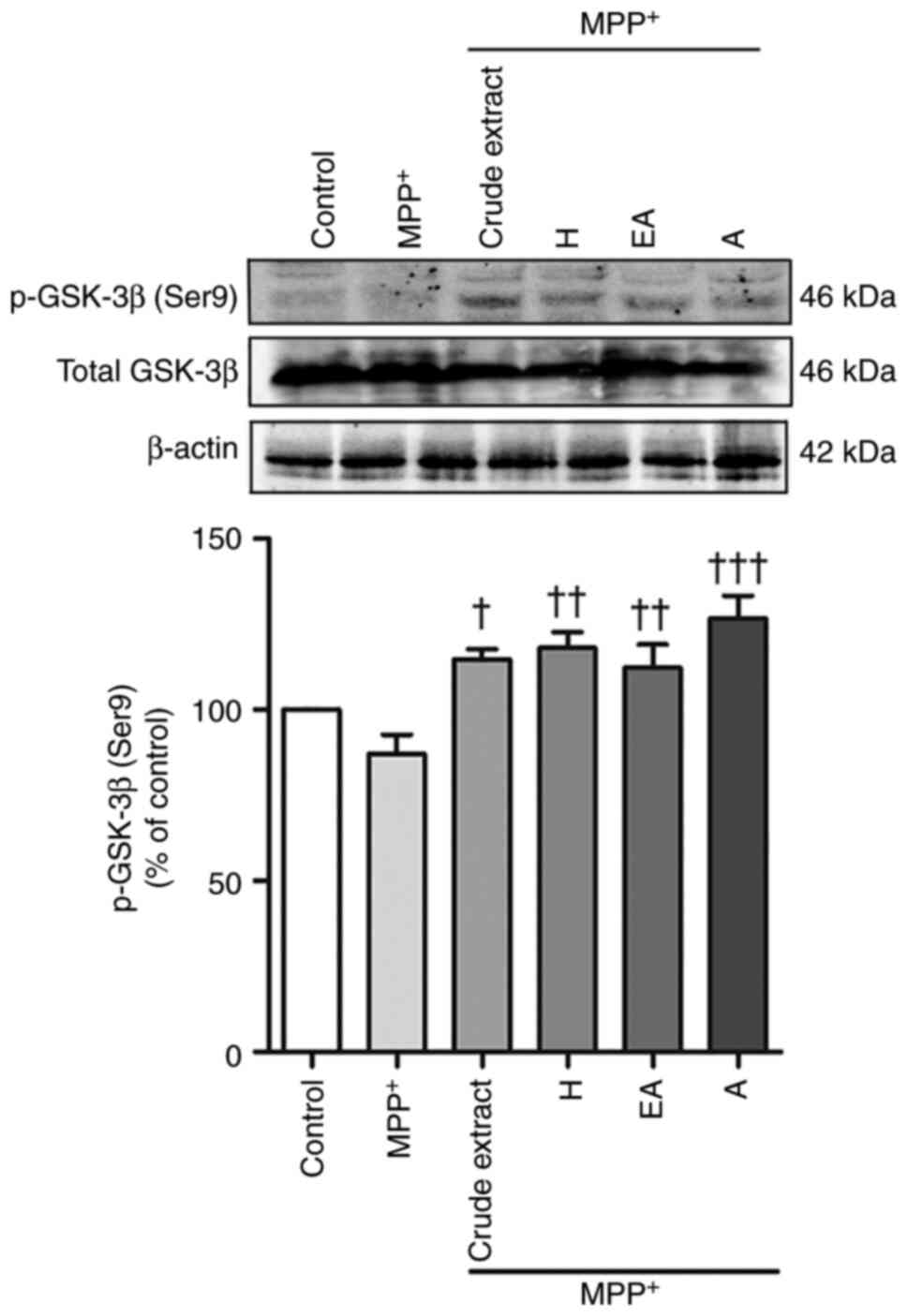Celastrus paniculatus seed extract exhibits neuroprotective effects against MPP+‑induced apoptotic cell death via GSK‑3β in a Parkinson's disease model
- Authors:
- Published online on: January 23, 2024 https://doi.org/10.3892/br.2024.1734
- Article Number: 46
Abstract
Introduction
Parkinson's disease (PD) is the second most common type of neurodegenerative disorder of aging, and it is characterized by selective and progressive loss of dopaminergic neurons in the substantia nigra pars compacta. While the etiology of dopaminergic neuronal loss remains unclear, several mechanisms have been suggested to be involved in the pathogenesis of PD, such as abnormal protein aggregation, mitochondrial dysfunction and oxidative stress (1). Together, these mechanisms are thought to be responsible for dopaminergic neurodegeneration via the induction of apoptosis.
1-Methyl-4-phenylpyridinium (MPP+) is the active metabolite of 1-methyl-4-phenyl-2,3,6-tetrahydropyridine, and is widely used in rodent and cellular models to elicit PD-associated neurochemical alterations. MPP+ causes apoptosis by inhibiting complex I of the mitochondrial electron transport chain (1-3). Notably, MPP+ can directly induce neuronal apoptosis (3). Numerous genes and their proteins are responsible for the progression of apoptosis; for example, within the Bcl-2 family, Bcl-2 is anti-apoptotic, whereas Bax is pro-apoptotic. MPP+-mediated cell death has been reported to be attenuated by Bcl-2 but is not affected by Bax (4). Glycogen synthase kinase-3β (GSK-3β) is involved in MPP+-induced dopaminergic cell death (5). A previous study showed that MPP+ treatment causes cell death via the time- and concentration-dependent activation of GSK-3β, as verified by upregulation of the active form of this kinase, phosphorylated (p)-GSK-3β at tyrosine 216(6). Furthermore, GSK-3β inhibition significantly decreases MPP+-induced neuron injury, ameliorates behavioral impairments caused by MPP+ and is a therapeutic target for PD (5).
Celastrus paniculatus (CP) Willd., belongs to the Celastraceae family (7,8), and is primarily distributed in tropical, subtropical and temperate zones of Asia. CP Willd. is indigenous to India but also grows in Australia, China, Malaysia, Cambodia, Taiwan, Indonesia, Laos, Myanmar and Thailand (9). Therefore, CP Willd. is not an endangered species of plant. CP seeds have been reported to exert antioxidant and neuroprotective activities (8,9). CP seeds and organic extracts can attenuate hydrogen peroxide- and glutamate-induced injury in embryonic rat neuronal cells (10). Moreover, the aqueous (A) extract of CP seeds has been reported to significantly decrease brain levels of malondialdehyde and significantly increase levels of glutathione and catalase. The aforementioned findings demonstrated that the A extract of CP seeds has an antioxidant effect on the brain (11). The methanolic extract of CP seeds has been shown to possess free radical-scavenging effects and can reduce hydrogen peroxide-induced cytotoxicity and DNA damage in human non-immortalized fibroblasts (12). Moreover, in vivo study has revealed that solvent extracts of the seeds can markedly increase and restore levels of antioxidant enzymes in acute and chronic immobilized stress mice (13). The antioxidant and anti-apoptotic activities of CP seed extract (CPSE) have been assessed in tertiary butyl hydroperoxide-induced muscle cell damage (14). Furthermore, CP exhibits anti-apoptotic effects in murine C2C12 myoblasts by regulating the expression levels of cytochrome c and heat shock protein 70(14). However, the underlying mechanisms by which CP mediates apoptotic inhibition in neuronal cells in PD is unclear. Thus, in the present study, MPP+ was used to induce cell death in SH-SY5Y neuronal cells and the protective effect of CPSE on MPP+-induced damage was investigated to provide novel insights into the mechanism by which it prevents apoptosis.
Materials and methods
CPSE preparation
CP seeds were kindly provided by Queen Sirikit Botanic Garden, Botanical Garden Organization of the Ministry of Natural Resources and Environment (Chiang Mai, Thailand). Dried plant material was ground into powder using a mill. The extraction process was conducted according to the maceration method, where CP seeds (300 g) were macerated with 95% ethanol at room temperature for 72 h. Thereafter, the filtrate was separated from the residue. This was repeated three times. The filtrate was combined and evaporated for 16 h under reduced pressure at 50˚C to obtain the crude ethanolic extract.
A part of the crude extract was dissolved in methanol and water (1:4 v/v). The extract solution was inserted into a separating funnel and n-hexane (H) solvent was then added with a volume ratio of 1:1 and shaken until the two solutions were mixed into one phase. When A and H phase were separated, and the H fraction was placed in a glass beaker. This process was repeated three times until the H fraction was almost clear. Fractionation was continued via the addition of ethyl acetate (EA) into the A fraction using a separating funnel (100 ml or in a 1:1 ratio). The same procedure was performed as in the H fraction. Then, each fraction was evaporated until dry using a rotary evaporator to obtain the H, EA and A fractions (Fig. 1). All extracts were refrigerated at 4˚C until further use.
Assessment of total phenolic content
The total phenolic content of extract was determined according to the method reported by Khongkaew and Chaemsawang (15). The phenolic component was obtained from CPSE: 25 µl Folin-Ciocalteu reagent was added to cause a reaction with the phenolic compound and then incubated at room temperature in a dark room for 6 min. Then, 100 µl 7.5% sodium carbonate was added to each well and incubated at room temperature for 90 min in the dark. Light absorption was analyzed at 765 nm using a microplate reader to calculate the total phenolic compound content in the extract and to compare it with the standard gallic acid. All samples were subtracted from the absorbance of the blank sample. The result was reported as µg gallic acid equivalent/mg extract.
Determination of the free radical-scavenging activity of 2,2-diphenyl-1-picrylhydrazyl (DPPH)
The antioxidant activity in terms of half-maximal inhibitory concentration (IC50), CPSE antioxidant capacity was measured on the basis of DPPH• scavenging. A 0.1 mM DPPH solution was prepared using 1.97 mg DPPH in 50 ml methanol The CPSE (100 µl) was added into 96-well plates with DPPH and incubated at room temperature in the dark for 30 min, after which, the wavelength was determined at 520 nm using a microplate reader. If the extract contains antioxidants, the purple color will change to yellow. Inhibition was calculated using the following equation: Inhibition (%)=[(absorbance of control-absorbance of sample)/absorbance of control) x100.
Determination of the free radical-scavenging activity of 2,2'-Azino-bis (3-ethylbenzthiazoline-6-sulphonic acid) (ABTS)
ABTS solution was mixed with potassium persulfate together in a 1:1 ratio and then incubated in the dark for 16 h at room temperature. Then, the crude extract, hexane fraction, ethyl acetate fraction and water fraction were taken and dissolved in methanol to a concentration of 1,000, 500, 300, 100 µg/ml. Subsequently, a volume of 100 µl/well was pipetted into a 96-well plate and 100 µl ABTS solution was added, and then incubated in the dark for 6 min at room temperature. The absorbance was then calculated at a wavelength of 734 nm. Inhibition was calculated using the following equation: Inhibition (%)=[(absorbance of control-absorbance of sample)/absorbance of control) x100.
SH-SY5Y cell culture
The SH-SY5Y neuroblastoma cell line was purchased from American Type Culture Collection. The cells were maintained in a 1:1 mixture of modified Eagle medium and Ham's F-12 nutrient mixture with 10% fetal bovine serum (Thermo Fisher Scientific, Inc.) at 37˚C in a humidified environment containing 5% CO2. The culture medium was changed every 3-4 days. SH-SY5Y cells were grown in a 6-well plate. CPSE was dissolved in dimethyl sulfoxide (DMSO) to a concentration of 100 µg/ml as a stock solution. The stock solution was diluted with complete medium before use. For pre-treatment, CPSE (10 µg/ml) was added to SH-SY5Y cells. Then, cells were maintained in a humidified 5% CO2 atmosphere at 37˚C for 24 h. After washing with 1X PBS, 2 mM MPP+ was added into the culture plate and incubated at room temperature for 3 h. In the CPSE post-treatment group, MPP+ was added 3 h before CPSE treatment.
Cell viability assay
Cell viability was assessed by MTT assay, which is based on the cleavage of tetrazolium salts by mitochondrial succinate reductase in viable cells to form formazan dye. SH-SY5Y cells were cultured in 96-well plates at a density of 1x104 cell/ml for 24 h. Following the aforementioned treatments, MTT (0.5 mg/ml) was added to each well and incubated for 3 h at 37˚C. The formazan crystals formed were then dissolved in DMSO. The absorbance was measured at 540 nm using a microplate reader and cell viability was expressed as the percentage of control.
Lactate dehydrogenase (LDH) leakage assay
LDH activities were measured spectrophotometrically by a CyQUANT™ LDH Cytotoxicity Assay (cat. no. C20300, Invitrogen™), using pyruvate as substrate, at 340 nm. Following the aforementioned treatments, an aliquot of the culture medium was taken to determine the activity of LDH that leaked through the cell membranes. Data are presented as the percentage of LDH leakage relative to the control. Four independent assays were conducted in triplicate.
WST-1 assay
Following 24 h treatment with all CP extract, cell vitality was measured quantitatively using the reagent WST-1. Cells were incubated with the reagent for 4 h at 37˚C. The absorption of the color product was measured at a 450/620 nm wavelength with a microplate reader. Each condition was tested in duplicate.
Western blotting
SH-SY5Y cells were harvested following the aforementioned treatments and lysed using Pierce® RIPA Buffer (Thermo Fisher Scientific, Inc.). For measuring the concentrations of proteins, Bradford protein assay is used. Subsequently, equal amounts of protein (30 µg) were separated by sodium dodecyl-sulfate polyacrylamide gel electrophoresis on 10% gels and transferred to nitrocellulose membranes. The membrane were blocked with 5% skim milk in TBST for 1 h at room temperature. The membranes were incubated with primary antibodies at a dilution of 1:1,000 as follows: Mouse anti-p-GSK-3β (Ser9; cat. No. 05-643), anti-GSK-3β (cat. No. G7914), anti-Bcl-2 (Cat. No. SAB4500003) and anti-β-actin (Cat. No. A2228) antibodies (all Sigma-Aldrich) for 24 h at 4˚C. Membranes were then probed with horseradish peroxidase-conjugated secondary antibodies (Cat. No. sc-2357; Santa Cruz Biotechnology, Inc.) at a dilution of 1:5,000 for 3 h at 4˚C and detected with Thermo Scientific SuperSignal® West Pico Substrate (Thermo Fisher Scientific, Inc.). Densitometric analysis was performed using the ImageJ analysis software version 1.48p (ImageJ, NIH, Bethesda, Maryland, USA) and results were normalized to β-actin.
Statistical analysis
All experiments were performed in triplicate. Data are presented as the mean ± SD. Statistical significance was analyzed with one-way analysis of variance followed by Tukey's post hoc test. All data were analyzed by GraphPad Prism version 7.0 (GraphPad Software Inc.; Dotmatics). P<0.05 was considered to indicate a statistically significant difference.
Results
Effect of CPSE and its fractions on SH-SY5Y cell viability
The present study determined the effect of different concentrations of CPSE and its fractions including H, EA, and A on SH-SY5Y cell viability. Cell viability was significantly increased following treatment with 10 µg/ml EA and A fractions but not in response to the crude extract or H fraction (Fig. 2A). In addition, treatment with EA and A fractions for 24 h significantly increased the viability of SH-SY5Y cells (Fig. 2B).
High concentrations of all CP fractions (200 µg/ml) and long-term CP treatment (48 h) did not affect cell viability. Viability was highest following treatment with all fractions 10 µg/ml for 24 h; therefore, this treatment condition was selected for further experiments.
Total phenolic content of CPSE and its fractions
The total phenolic content of CPSE and its fractions was quantified (Table I). The A fraction presented the highest levels of individual phenolic compounds (30.20 µg/100 g), followed by EA (21.40 µg/100 g) and H fractions (8.83 µg/100 g). The crude extract had a low phenolic content (3.01 µg/100 g).
Table ITotal phenolic content of Celastrus paniculatus seed fractions extracted with hexane, ethyl acetate and water. |
Antioxidant activity of CPSE and its fractions
The antioxidative mechanisms of CPSE and its fractions were assessed using ABTS and DPPH assays (Table II). In the EA fraction, half-maximal inhibitory concentration (IC50) values tested by ABTS and DPPH were 492.11±43.92 and 1462.84±233.20 µg/ml, respectively; in the A fraction, the IC50 values were 393.35±32.53 and 719.17±107.50 µg/ml, respectively. In the crude extract and H fraction, higher IC50 values indicated low antioxidant capacity.
Table IIAntioxidant activity of Celastrus paniculatus seed extracts assessed by ABTS and DPPH assays. |
CPSE and its fractions decrease MPP+-treated SH-SY5Y cell death
Oxidative stress and activation of the apoptotic cascade serve central roles in the pathogenesis of PD (1). Thus, to investigate the potential effect of CPSE and its fractions on MPP+-induced SH-SY5Y cell injury, SH-SY5Y cells treated with crude extract, H, EA or A fractions were stimulated with 2 mM MPP+ for 3 h before or after CPSE treatment, followed by the MTT assay (Fig. 3A and B). Treatment with 2 mM MPP+ resulted in decreased viability of SH-SY5Y cells, whereas treatments with all types of CPSE did not significantly affect the viability of SH-SY5Y cells compared with control. Both CPSE pre- and post-treatment reversed the MPP+-induced reduction of SH-SY5Y cell viability, especially H, EA or A fractions.
CPSE and its fractions increase the proliferation of MPP+-induced SH-SY5Y cells
The balance between apoptosis and proliferation is key to maintaining normal cell activity. Cell proliferation was evaluated by WST-1 assay. Similar to the MTT assay, pre-treatment with H, EA and A fractions significantly increased the proliferation of MPP+-treated cells. (Fig. 4A). Post-treatment with all CPSE fractions increased the proliferation of MPP+-treated cells (Fig. 4B). This confirmed the significant neuroprotective effect of CPSE when administered either before or after MPP+ treatment.
CPSE and its fractions alleviate MPP+-induced SH-SY5Y cell damage
To explore the neuroprotective effect of CPSE on MPP+-induced cell injury, SH-SY5Y cells were treated with CPSE 24 h before MPP+ treatment or after 3 h of MPP+ treatment. LDH is rapidly released into the cell culture supernatant when the plasma membrane is damaged, a key feature of cells undergoing apoptosis (14). MPP+ treatment significantly increased cytoplasmic LDH release; this was partially restored by CPSE and its fractions (Fig. 5). Therefore, both pre- and post-treatment of CPSE alleviated MPP+-induced SH-SY5Y cell damage. However, post-treatment with CPSE and H fraction did not significantly affect LDH levels (Fig. 5B).
CPSE and its fractions attenuate MPP+-decreased Bcl-2 protein expression
The expression levels of anti-apoptotic proteins following MPP+ treatment with CPSE post-treatment were examined by western blot analysis. SH-SY5Y cells treated with MPP+ had decreased levels of the anti-apoptotic protein Bcl-2 (63.86±4.2%) compared with control; however, the protein expression levels of Bcl-2 were significantly increased in the EA- and A-treated groups (Fig. 6). The expression levels of Bcl-2 indicate the susceptibility of cells to apoptosis (4,16). These data suggested that MPP+ can induce the apoptosis of SH-SY5Y cells and CPSE treatment can protect SH-SY5Y cells by upregulating Bcl-2 expression.
Neuroprotective effects of CPSE and its fractions are involved in p-GSK-3β (Ser9) expression
Since a previous study reported that GSK-3β is involved in MPP+-induced SH-SY5Y cells, the present study investigated the expression levels of this protein (5). The results showed that MPP+ treatment reduced expression (but not but not statistically significant) of p-GSK-3β (Ser9), whereas post-treatment with crude extract, H, EA and A fractions significantly increased the expression levels of p-GSK-3β (Ser9) compared with those in the MPP+-treated group (Fig. 7). This phosphoserine exerts an inhibitory effect on the kinase by blocking the catalytic site; therefore, low p-GSK-3β (Ser9) levels can indicate increased kinase activity (6).
Discussion
The present study showed the effect of CPSE on cell viability according to the MTT assay. Treatment with 10 µg/ml EA or A fraction for 24 h effectively increased the viability of SH-SY5Y cells. Furthermore, the A fraction had the highest total phenolic content and free radical-scavenging activities. In addition, H, EA and A fractions consistently attenuated MPP+-induced toxicity both pre- and post-treatment according to the MTT, WST-1 and LDH assays. Post-treatment with CPSE could inhibit MPP+-induced cell death via the induction of the anti-apoptotic protein Bcl-2, and Bcl-2 increased with the expression of p-GSK-3β (Ser9) measured in SH-SY5Y cells. However, the present study lacked verification in another neuronal cell line or animal models. Therefore, MPP+-induced PD rat models should be further used.
Despite several reports regarding the neuroprotective effect of CP seeds on damage induced by several toxins, including N-methyl-D-aspartate (17), 3-nitropropionic acid and MPP+ (18), the mechanism by which CP affects neurons exposed to MPP+ is unknown. MPP+ inhibits complex I activity of the mitochondrial transport chain, and it enters dopaminergic neurons via dopamine transporters and is transported into the mitochondria according to the mitochondrial membrane potential (2). Since MPP+ treatment induces selective dopaminergic neuronal degeneration, this agent is commonly used to study the pathogenesis of PD (4,6). In a recent study, overnight treatment with 9 µg/ml CPSE yielded a significant neuroprotective effect against MPP+-induced dopaminergic degeneration in a Caenorhabditis elegans model of PD (18). Moreover, a previous study showed that CPSE decreases the intraneuronal Ca2+ concentration in CP-treated mice. Furthermore, CPSE treatment ameliorates the expression of Bax, Bcl-2 and caspase-3 in the brain tissue of glutamate-induced brain-injured mice (16). Here, 24 h treatment with 10 µg/ml CPSE exerted a significant anti-apoptotic effect by increasing the expression levels of Bcl-2. Therefore, CPSE treatment may attenuate MPP+-induced neuronal apoptosis by increasing the expression levels of the anti-apoptotic protein Bcl-2. These findings indicated that CPSE may attenuate MPP+-induced neuronal toxicity in a cell model of PD, which may be associated with inhibition of apoptosis. Notably, mitochondrial dysfunction serves a central role in the pathogenesis of PD; however, the present study did not directly explore mitochondrial function.
The PI3K/Akt signaling pathway is significantly associated with neuronal survival/degeneration. Inactivation of Akt triggers GSK-3β activity by decreasing its phosphorylation at serine 9, which serves a key role in the neuronal loss that occurs in neurodegenerative diseases, including PD (5). MPP+ has been reported to induce GSK-3β-dependent neurodegeneration in cells, including SH-ST5Y cells, thus suggesting that GSK-3β may be considered a key mediator of neuronal death (6). In the present study, MPP+ treatment reduced the expression levels of p-GSK-3β (Ser9). Moreover, this result was consistent with previous evidence that CPSE treatment inhibits the occurrence of lead acetate-induced degenerative changes in the renal tubules with significantly increased PI3K and AKT mRNA expression levels in CP-treated rats (19) This previous finding indicated that CPSE may inhibit lead acetate-induced detrimental changes in the kidneys by regulating the PI3K/AKT signaling pathway (19). Since the phosphorylation status of GSK-3β is primarily regulated by AKT, and various stimulating factors activate the PI3K/AKT pathway (5), the present study suggested that CPSE inhibited the MPP+-induced model of PD in SH-SY5Y cells by regulating PI3K/AKT/GSK-3β signaling.
To the best of our knowledge, the present study is the first to provide the therapeutic potential of three fractions extracted from CP seed, as H, EA and A. The A fraction of CPSE had the highest antioxidant capacity, whereas the crude extract had low phenolic content, since the crude extract contains compounds other than phenolic compounds, such as fat, which is commonly found in plant seeds (20). This finding information supports the idea that phenolic compounds are soluble in polar or semipolar solvents such as water, ethanol, or EA (21). Accordingly, compounds mostly found in the A layer were low molecular weight phenolics, such as gallic acid and flavonoids (21). Similarly, a previous study using okra seeds found significant levels of flavonoid glycosides, such as high-polar isoquercitrin (22). According to a study by Popoola (23) on the extraction of Nigerian Amaranthus viridis seeds, in addition to oils, phenolics and flavonoids, such as vanillic and caffeic acid, quercetin diglycoside and kaempferol diglycoside were found. This is consistent with the present phenolic content analysis because phenolics and flavonoids are reported to have good antioxidant properties (21). As the phenolic content in the A fraction in the present study was high, its antioxidation potential is high. Antioxidant capacity detected by ABTS assay has been reported to be significantly higher for a variety of foods compared with that of the DPPH assay, partly because the highly pigmented and hydrophilic antioxidants are better reflected by the ABTS assay than the DPPH assay (24). Recently, a study showed that the active metabolites of CP comprise dihydro-β-agarofuran sesquiterpenoids, characterized by a tricyclic architecture comprising trans-decalin and tetrahydrofuran rings and oxygen functionalities (25). The biological activity of dihydro-β-agarofuran sesquiterpenoids includes multidrug resistance reversal activity, cytotoxicity, antitumor activity and insecticidal activity (26). Dihydro-β-agarofuran sesquiterpenoids have been evaluated for their in vitro cytotoxic activity against human cancer cell lines, including HepG2 and MCF-7 (26,27). However, further studies on normal cells are needed to confirm the neuroprotective effects of dihydro-β-agarofuran sesquiterpenoids.
In conclusion, the present results suggested that CPSE exhibited neuroprotective effects on an MPP+-induced cell model of PD. The neuroprotective effect of CPSE may be due to its stimulatory actions on the upregulation of Bcl-2 and p-GSK-3β (Ser9) expression levels, and improvement of mitochondrial function. Therefore, CPSE may serve as a preventative and therapeutic agent for PD, and its application in animal models of PD needs further exploration.
Acknowledgements
The authors would like to thank Queen Sirikit Botanic Garden, Botanical Garden Organization of the Ministry of Natural Resources and Environment, (Chiang Mai, Thailand) for kindly providing the Celastrus paniculatus Willd. seeds.
Funding
Funding: The present study was supported by the Burapha University and Thailand Science Research and Innovation (grant no. 47/2565), the Burapha University through the National Research Council of Thailand (grant no. 16/2562) and the Faculty of Allied Health Sciences, Burapha University (grant nos. AHS3/2562 and AHS04/2565).
Availability of data and materials
The datasets used and/or analyzed during the current study are available from the corresponding author on reasonable request.
Authors' contributions
TP and SC conceived the study. TP performed the experiments. WC, NT and AA verified the statistical analysis. All authors discussed the results and commented on the manuscript. SC wrote the manuscript. All authors have read and approved the final manuscript. TP and SC confirm the authenticity of all the raw data.
Ethics approval and consent to participate
Not applicable.
Patient consent for publication
Not applicable.
Competing interests
The authors declare that they have no competing interests.
References
|
Lin MT and Beal MF: Mitochondrial dysfunction and oxidative stress in neurodegenerative diseases. Nature. 443:787–795. 2006.PubMed/NCBI View Article : Google Scholar | |
|
Singer TP and Ramsay RR: Mechanism of the neurotoxicity of MPTP. An update. FEBS Lett. 274:1–8. 1990.PubMed/NCBI View Article : Google Scholar | |
|
Enogieru AB, Haylett W, Hiss DC and Ekpo OE: Regulation of AKT/AMPK signaling, autophagy and mitigation of apoptosis in rutin-pretreated SH-SY5Y cells exposed to MPP. Metab Brain Dis. 36:315–326. 2021.PubMed/NCBI View Article : Google Scholar | |
|
O'Malley KL, Liu J, Lotharius J and Holtz W: Targeted expression of BCL-2 attenuates MPP+ but not 6-OHDA induced cell death in dopaminergic neurons. Neurobiol Dis. 14:43–51. 2003.PubMed/NCBI View Article : Google Scholar | |
|
Li J, Ma S, Chen J, Hu K, Li Y, Zhang Z, Su Z, Woodgett JR, Li M and Huang Q: GSK-3β contributes to parkinsonian dopaminergic neuron death: Evidence from conditional knockout mice and tideglusib. Front Mol Neurosci. 13(81)2020.PubMed/NCBI View Article : Google Scholar | |
|
Petit-Paitel A, Brau F, Cazareth J and Chabry J: Involvement of cytosolic and mitochondrial GSK-3beta in mitochondrial dysfunction and neuronal cell death of MPTP/MPP-treated neurons. PLoS One. 4(e5491)2009.PubMed/NCBI View Article : Google Scholar | |
|
Kulkarni YA, Agarwal S and Garud MS: Effect of Jyotishmati (Celastrus paniculatus) seeds in animal models of pain and inflammation. J Ayurveda Integr Med. 6:82–88. 2015.PubMed/NCBI View Article : Google Scholar | |
|
Bhagya V, Christofer T and Shankaranarayana Rao BS: Neuroprotective effect of Celastrus paniculatus on chronic stress-induced cognitive impairment. Indian J Pharmacol. 48:687–693. 2016.PubMed/NCBI View Article : Google Scholar | |
|
Bhanumathy M, Harish MS, Shivaprasad HN and Sushma G: Nootropic activity of Celastrus paniculatus seed. Pharm Biol. 48:324–327. 2010.PubMed/NCBI View Article : Google Scholar | |
|
Godkar PB, Gordon RK, Ravindran A and Doctor BP: Celastrus paniculatus seed oil and organic extracts attenuate hydrogen peroxide- and glutamate-induced injury in embryonic rat forebrain neuronal cells. Phytomedicine. 13:29–36. 2006.PubMed/NCBI View Article : Google Scholar | |
|
Kumar MH and Gupta YK: Antioxidant property of Celastrus paniculatus willd.: A possible mechanism in enhancing cognition. Phytomedicine. 9:302–311. 2002.PubMed/NCBI View Article : Google Scholar | |
|
Russo A, Izzo AA, Cardile V, Borrelli F and Vanella A: Indian medicinal plants as antiradicals and DNA cleavage protectors. Phytomedicine. 8:125–132. 2001.PubMed/NCBI View Article : Google Scholar | |
|
Lekha G, Mohan K and Samy IA: Effect of Celastrus paniculatus seed oil (Jyothismati oil) on acute and chronic immobilization stress induced in swiss albino mice. Pharmacogn Res. 2:169–174. 2010.PubMed/NCBI View Article : Google Scholar | |
|
Kumar KH, Venuprasad MP, Jayashree GV, Rachitha P, Krupashree K, Pal A and Khanum F: Celastrus paniculatus Willd. mitigates t-BHP induced oxidative and apoptotic damage in C2C12 murine muscle cells. Cytotechnology. 67:955–967. 2015.PubMed/NCBI View Article : Google Scholar | |
|
Khongkaew P and Chaemsawang W: Development and characterization of stingless bee propolis properties for the development of solid lipid nanoparticles for loading lipophilic substances. Int J Biomater. 2021(6662867)2021.PubMed/NCBI View Article : Google Scholar | |
|
John E, Mishra B, Tripathi AS and Aleesha R: Protective effect of Celastrus paniculatus on cognitive function in glutamate-induced brain-injured mice by reducing the intracellular influx of Ca. Int J Dev Neurosci. 82:331–338. 2022.PubMed/NCBI View Article : Google Scholar | |
|
Godkar PB, Gordon RK, Ravindran A and Doctor BP: Celastrus paniculatus seed water soluble extracts protect against glutamate toxicity in neuronal cultures from rat forebrain. J Ethnopharmacol. 93:213–219. 2004.PubMed/NCBI View Article : Google Scholar | |
|
Anjaneyulu J, R V and Godbole A: Differential effect of ayurvedic nootropics on C. elegans models of Parkinson's disease. J Ayurveda Integr Med. 11:440–447. 2020.PubMed/NCBI View Article : Google Scholar | |
|
Balaji K, Vijayakumar J, Sankaran PK, Senthilkumar S, Vijayaraghavan R, Selvaraj J and Yuvaraj MF: Molecular studies on the nephroprotective potential of Celastrus paniculatus against lead-acetate-induced nephrotoxicity in experimental rats: Role of the PI3K/AKT signaling pathway. Molecules. 26(6647)2021.PubMed/NCBI View Article : Google Scholar | |
|
Martins-Noguerol R, Pérez-Ramos IM, Matías L, Moreira X, Francisco M, García-González A, Troncoso-Ponce AM, Thomasset B, Martínez-Force E, Moreno-Pérez AJ and Cambrollé J: Crithmum maritimum seeds, a potential source for high-quality oil and phenolic compounds in soils with no agronomical relevance. J Food Compos Anal. 108(104413)2022. | |
|
Kagan IA: Soluble phenolic compounds of perennial ryegrass (Lolium perenne L.): Potential effects on animal performance, and challenges in determining profiles and concentrations. Anim Feed Sci Technol. 277(114960)2021. | |
|
Chaemsawang W, Prasongchean W, Papadopoulos KI, Ritthidej G, Sukrong S and Wattanaarsakit P: The effect of Okra (Abelmoschus esculentus (L.) Moench) eeed extract on human cancer cell lines delivered in its native form and loaded in polymeric micelles. Int J Biomater. 2019(9404383)2019.PubMed/NCBI View Article : Google Scholar | |
|
Popoola OO: Phenolic compounds composition and in vitro antioxidant activity of Nigerian Amaranthus viridis seed as affected by autoclaving and germination. Meas Food. 6(100028)2022. | |
|
Thaipong K, Boonprakob U, Crosby K, Cisneros-Zevallos L and Hawkins Byrne D: Comparison of ABTS, DPPH, FRAP, and ORAC assays for estimating antioxidant activity from guava fruit extracts. J Food Compos Anal. 19:669–675. 2006. | |
|
Aleem M: Phytochemistry and pharmacology of Celastrus paniculatus Wild: A nootropic drug. J Complement Integr Med. 20:24–46. 2021.PubMed/NCBI View Article : Google Scholar | |
|
Yang T, Wang S, Zheng H, Wang L, Liu D, Chen X and Li R: Understanding dihydro-β-agarofuran sesquiterpenes from Tripterygium hypoglaucum as the modulators of multi-drug resistance in HepG2/Adr cells. Biochem Biophys Res Commun. 508:742–748. 2019.PubMed/NCBI View Article : Google Scholar | |
|
Weng JR, Yen MH and Lin WY: Cytotoxic constituents from Celastrus paniculatus induce apoptosis and autophagy in breast cancer cells. Phytochemistry. 94:211–219. 2013.PubMed/NCBI View Article : Google Scholar |



